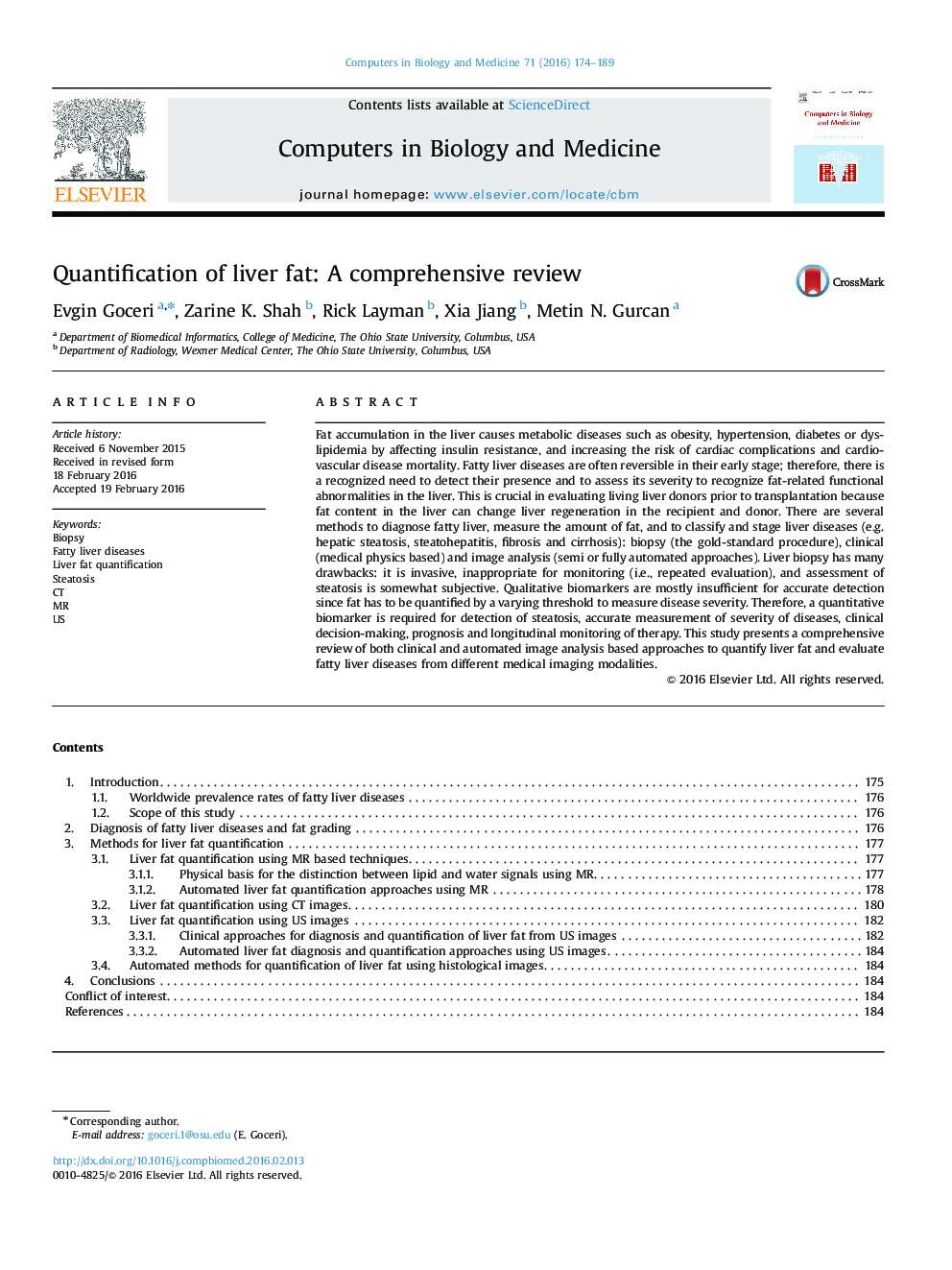| کد مقاله | کد نشریه | سال انتشار | مقاله انگلیسی | نسخه تمام متن |
|---|---|---|---|---|
| 6920884 | 864476 | 2016 | 16 صفحه PDF | دانلود رایگان |
عنوان انگلیسی مقاله ISI
Quantification of liver fat: A comprehensive review
ترجمه فارسی عنوان
کافی بودن چربی کبد: یک بررسی جامع
دانلود مقاله + سفارش ترجمه
دانلود مقاله ISI انگلیسی
رایگان برای ایرانیان
ترجمه چکیده
تجمع چربی در کبد باعث ایجاد بیماری های متابولیکی مانند چاقی، فشار خون بالا، دیابت یا دیس لیپیدمی با تأثیر مقاومت انسولین و افزایش خطر عوارض قلبی و مرگ و میر بیماری های قلبی عروقی می شود. بیماری های کبدی چربی اغلب در اوایل مرحله برگشت پذیر هستند؛ بنابراین نیاز شناخته شده برای تشخیص حضور آنها و ارزیابی شدت آن برای تشخیص اختلالات عملکردی مرتبط با چربی در کبد وجود دارد. این در ارزیابی اهداکنندگان زنده کبد قبل از پیوند حیاتی است زیرا میزان چربی در کبد می تواند بازسازی کبد را در گیرنده و اهدا کننده تغییر دهد. روش های متعددی برای تشخیص کبد چرب، اندازه گیری میزان چربی و طبقه بندی و مقابله با بیماری های کبدی وجود دارد (مثل استئاتوز کبدی، استئاتو هپاتیت، فیبروز و سیروز): بیوپسی (روش طلای استاندارد)، بالینی (فیزیک پزشکی مبتنی بر) و تجزیه و تحلیل تصویر (روش نیمه یا کاملا خودکار). بیوپسی کبدی دارای نقایص بسیاری است: آن مهاجم، نامناسب برای نظارت (به عنوان مثال، ارزیابی مکرر) است، و ارزیابی استئاتوز تا حدودی ذهنی است. بیومارکرهای کافی برای تشخیص دقیق برای تشخیص دقیق کافی نیستند زیرا چربی باید با آستانه متفاوت برای سنجش شدت بیماری محاسبه شود. بنابراین، برای نشان دادن استئاتوز، اندازه گیری دقیق شدت بیماری ها، تصمیم گیری بالینی، پیش آگهی و نظارت طولی بر روی درمان، یک بیومارکر کمی وجود دارد. این مطالعه یک بررسی جامع از روش های مبتنی بر تحلیل تصویری بالینی و خودکار را برای اندازه گیری چربی های کبدی و بررسی بیماری های کبدی چربی از روش های مختلف تصویر برداری پزشکی ارائه می دهد.
موضوعات مرتبط
مهندسی و علوم پایه
مهندسی کامپیوتر
نرم افزارهای علوم کامپیوتر
چکیده انگلیسی
Fat accumulation in the liver causes metabolic diseases such as obesity, hypertension, diabetes or dyslipidemia by affecting insulin resistance, and increasing the risk of cardiac complications and cardiovascular disease mortality. Fatty liver diseases are often reversible in their early stage; therefore, there is a recognized need to detect their presence and to assess its severity to recognize fat-related functional abnormalities in the liver. This is crucial in evaluating living liver donors prior to transplantation because fat content in the liver can change liver regeneration in the recipient and donor. There are several methods to diagnose fatty liver, measure the amount of fat, and to classify and stage liver diseases (e.g. hepatic steatosis, steatohepatitis, fibrosis and cirrhosis): biopsy (the gold-standard procedure), clinical (medical physics based) and image analysis (semi or fully automated approaches). Liver biopsy has many drawbacks: it is invasive, inappropriate for monitoring (i.e., repeated evaluation), and assessment of steatosis is somewhat subjective. Qualitative biomarkers are mostly insufficient for accurate detection since fat has to be quantified by a varying threshold to measure disease severity. Therefore, a quantitative biomarker is required for detection of steatosis, accurate measurement of severity of diseases, clinical decision-making, prognosis and longitudinal monitoring of therapy. This study presents a comprehensive review of both clinical and automated image analysis based approaches to quantify liver fat and evaluate fatty liver diseases from different medical imaging modalities.
ناشر
Database: Elsevier - ScienceDirect (ساینس دایرکت)
Journal: Computers in Biology and Medicine - Volume 71, 1 April 2016, Pages 174-189
Journal: Computers in Biology and Medicine - Volume 71, 1 April 2016, Pages 174-189
نویسندگان
Evgin Goceri, Zarine K. Shah, Rick Layman, Xia Jiang, Metin N. Gurcan,
